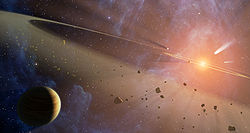Epsilon Eridani
 There's something missing here… There's something missing here…This page is missing critical information of some kind. It might need a location, or names of people involved, or something else. It might be outdated. It might be a Wikipedia or SolStation data dump with little or no relation – or, worse yet, with contradictions – to the situation in Fenspace. It might have inconsistencies. It might even be missing multiple details. You can help FenWiki by expanding this page. |
| Epsilon Eridani | |
 The Epsilon Eridani system as envisioned by NASA/JPL-Caltech | |
| Stellar characteristics | |
|---|---|
| Constellation | Eridanus |
| Right ascension (Epoch J2000) | 03h 32m 55.8442s |
| Declination (Epoch J2000) | -09° 27' 29.744" |
| Spectral type | K2V |
| Distance from Sol | 10.5 ± 0.03 ly |
| Other designations | 18 Eridani, BD -09°697, GCTP 742.00, GJ 144, HD 22049, HIP 16537, HR 1084, LHS 1557, SAO 130564, WDS 03330-0928. |
| Planets | Epsilon Eridani b |
Epsilon Eridani is located only about 10.5 light-years (ly) away in the northeastern part of the constellation Eridanus, the River. Somewhat smaller and cooler than our own Sun, Sol, Epsilon Eridani is also less luminous. In Earth's night sky, however, it is clearly visible to the naked eye as the third closest star viewable without a telescope.
Contents
Shameless Copypasta from NASA/JPL
Observations from NASA's Spitzer Space Telescope show that the system hosts two asteroid belts, in addition to previously identified candidate planets and an outer comet ring.
Epsilon Eridani is located about 10 light-years away in the constellation Eridanus. It is visible in the night skies with the naked eye.
The system's inner asteroid belt appears as the yellowish ring around the star, while the outer asteroid belt is in the foreground. The outermost comet ring is too far out to be seen in this view, but comets originating from it are shown in the upper right corner.
Astronomers think that each of Epsilon Eridani's asteroid belts could have a planet orbiting just outside it, shepherding its rocky debris into a ring in the same way that Jupiter helps keep our asteroid belt confined. The planet near the inner belt was previously identified in 2000 via the radial velocity, or "star wobble," technique, while the planet near the outer belt was inferred when Spitzer discovered the belt.
The inner belt orbits at a distance of about 3 astronomical units from its star -- or about the same position as the asteroid belt in our own solar system (an astronomical unit is the distance between Earth and our sun). The second asteroid belt lies at about 20 astronomical units from the star, or a position comparable to Uranus in our solar system. The outer comet ring orbits from 35 to 90 astronomical units from the star; our solar system's analogous Kuiper Belt extends from about 30 to 50 astronomical units from the sun.
Shameless Copypasta from SolStation
The Epilson Eridani system has two asteroid belts made of rocky and metallic debris left over from the early stages of planetary formation[1]. The innermost debris belt is located roughly around the same position as the Main Asteroid Belt in our solar system and is rich in silicate dust[2], while the second, denser belt (which is also mostly likely to be composed of bodies rich in rock as well as ices) lies between the first belt and a broad, outer ring of icy bodies at 35 to 90 AUs out from Epsilon Eridani that is similar to the Solar System's Edgeworth-Kuiper Belt.
This main sequence, orange-red dwarf (K2 V) is a relative young star that may be around 850 million years old, within the range between 500 million to a billion years old[2][3][4]. It may have about 83 (+/- 0.05) to 85 percent of Sol's mass[3][5], 84 percent of its diameter[6], but only about 27.8 percent of its luminosity[7].
The distance from Epsilon Eridani where an Earth-type rocky planet may have liquid water on its surface may have to be between 0.47 and 0.91 AU[8] -- between the orbital distances of Mercury and Earth in the Solar System. In that distance range from the star, such a planet would have an orbital period shorter an Earth year.
Known Places Around Epsilon Eridani
- Arcadia An Earth like planet in the liquid water zone with large oceans. The Iconian Gate has crashed on the surface of the planet at an unknown time in the past.
- Epsilon Eridani b A Jupiter class planet with a mass of about 1.55 times that of Jupiter. Its orbit has an average radius of 3.39 AUs and takes about 6.9 years to complete. At its maximum distance of 5.8 AU from its primary any water on its moons would freeze. However, under certain conditions life could survive in these circumstances.
- Starbase 3 (Fenspace Infinities), orbiting Epsilon Eridani b
Notes
Some data from NASA-JPL Spitzer Space Telescope website and SolStation.com
- ↑ (Spitzer press release)
- ↑ 2.0 2.1 (Backman et al, 2008)
- ↑ 3.0 3.1 (Benedict et al, 2006)
- ↑ (Saffe et al, 2005)
- ↑ (RECONS)
- ↑ (Johnson and Wright, 1983, page 653)
- ↑ (Saumon et al, 1996, page 17)
- ↑ (Jones and Sleep, 2003)